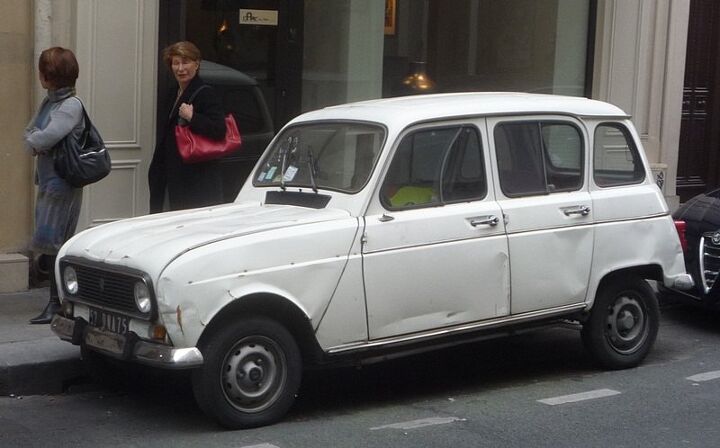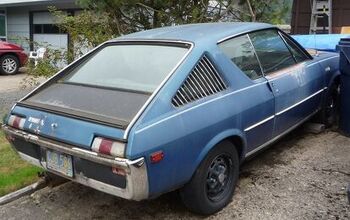Le Curbside Classic: Renault R4

Despite being in sensual Paris, no one is going to accuse me of shameless sexual exploitation by posting this ugly little R4, or the woman behind it. I was late on the draw, and just missed a gaggle of cute girls who just walked behind it thirty seconds earlier. Why do they all have to smoke, though? Back to the subject at hand: I know many Americans may barely know know of the R4’s existence, and would be quite happy to go their graves without being enlightened to its Gallic charms. But it does represents one of the most important milestone in the development of the modern car: this lowly little box created and defined the whole genre of the compact hatchback. And it has a few other significant honors in its resumé. So put your anti Frenchy-car bias aside for a few minutes, and I promise to make it quick. And I have a bit of sexiness for the end.
Everyone recognizes that quintessential French small car, the Citroen 2CV ( TTAC review here). Although it became an evergreen as well as an icon, in reality it also became outmoded for the rank and file French drivers pretty early on. By 1960, it was already looking dated, and its tiny two-cylinder engine was noisy, slow, and didn’t generate any real heat in the winter. Renault recognized this, and wisely decided to develop what essentially became the 2CV’s successor as well as competitor.
Introduced in 1961, just as French incomes were rising, the R4 was a significant step up: a water cooled four, a roomy body with a rear luggage area accessible with a lift-up hatch, more comfortable seats, and of course that famous French-car cushy suspension, which Renault blatantly stole from Citroen. By recycling the engine and transmission from their rear-engined 4CV, Renault saved development time and money. That did mean the engine was behind the front wheels, which explains why they’re so far forward.
It’s the “classic” fwd layout, as pioneered by the Miller racing cars of the twenties and the Cord L-29, and the Citroen Traction Avant. It’s not as space efficient as the transverse engine configuration, but it got the job done, as long as you found a way to get the transmission linkage past the engine to that tranny sticking out front. Renault used the “umbrella handle” approach, with the lever sticking out horizontally from the dash, and the linkage running right over the engine.
The R4 started out with the 4CV’s 747 cc mill, but most versions used an 845 cc version. And starting in 1978, the GTL version came with a whopping 1108 cc motor. That was what my cousin had, when he took us on a few hair-raising rides through the narrow roads of Vienna at night in 1980. European city cars don’t need big engines to “win” the urban battles; their drivers just need big balls.
As mentioned earlier, the suspension was largely copied from the Citroen set up, with enormous amounts of wheel travel and very soft springs; that’s why the rear end sits up so high. This arrangement allowed for a remarkably soft ride over the roughest cobblestones and bad pavement. In curves, these cars lean crazily, and look like they’re just about to flip, but never seem to actually, their skinny little Michelin radials seemingly stuck to the pavement. Bob Lutz would have been frustrated. On oddity of the Renault is that its wheelbase is different on each side, since the rear torsion bars are transverse, and run the full width of the car. It had no effect on the handling.
The R4 gave birth to several offshoots: the very similar but more upscale R6 shared the same platform frame, and the very popular R5 ( Le Car in the US) was also derived from the R4, sharing its drive train and suspension, but now attached to a new unibody. And although the van-version Fourgette (above) also imitated the 2CV version, it became the definitive vehicle of its kind, and spawned what is now a huge category throughout Europe and other continents.
Before you slam me about there being other hatchback cars before the R4, yes, technically, there were a few. But they weren’t in the class, size and popularity of the R4. It was a fairly radical new step in the small car’s evolution, and one that was soon adopted almost universally, especially in Europe. IKEA owes its whole existence to the R4.
The R4 was a huge hit for Renault, and it was built throughout the world (USA excepted). And it was a hard car to replace, as it still sold very well into the eighties. Production finally ended in 1994, after a thirty-three year run. But it’s been immortalized with cult status, including a kit to transform a Suzuki Lapin into an R4 look-alike.
Renault left a bad taste in Americans’ mouths, with a reputation for fragility. There’s no question that Renaults, and most European cars back then were designed for different conditions: short trips, and some weekend outings. Americans punish cars, and the Renaults withered in their hands. Lousy dealer service was the final nail in the coffin. European cars have of course dramatically improved since then, but the R4 and its ilk is considered a quite robust car here. And R5s are still very common on the streets.
And here’s that sexy ending I promised: a delicious Alfa GT Coupe. How’s that for a contrast?

More by Paul Niedermeyer
Latest Car Reviews
Read moreLatest Product Reviews
Read moreRecent Comments
- James Jones The only thing that concerns ,me is a government-mandated back door--you get in and your car drives you to the police station where yo are arrested for crimes against the state, or "you can't drive because we must achieve our energy conservation goals". Not to mention that once there's a back door, any sufficiently smart person can use it--you can't create a back door only usable by those whose hearts are true. So then there'd be the risk of someone telling my self-driving car to drive off the side of a mountain/into a river/etc.
- 3-On-The-Tree Jeff I also have a 1980 Suzuki GS1000G I rode during college and it was a lot of fun. My other bike was a 1977 Suzuki GT 750 2 stroke. My post army retirement time will be restoring those old bikes next to the 02 Hayabusa, 05 Suzuki Vstrom and klr 650. I love riding but at much reduced speeds nowadays. I got it out of my system as a young flight Lieutenant.
- Canam23 I really like the Rivian, but no matter what it's payload is, it will be completely weighed down by smugness if they team up with Apple.
- Fed65767768 Good Christ, no.CP.
- Kwik_Shift_Pro4X The main advice I've heard is to stay away from the BMW engine.






































Comments
Join the conversation
wow, this is the car of my childhood! my parents bought one of the first R4 gtl in the late 70s, it was the 1100cc 34hp and that car was with us for about 25 years and 200 000km. we are not car collectors, we haven't a garage and we don't spend alot of money on cars. in my familly cars are used to go from one place to another and when they become unreliable we sold or send to the junkyard. no other cars in my familly lasted as the R4 did, it was used by my parents as first car and then as a second car. we used this little renault to go to the seaside, to ski, to school, to work and it did the job much better than my new mitsubishi colt does. once i could fit a 25hp outboard in the trunk and a inflatable boat on the roof. it was very reliable too, you only needed to clean the spark plugs sometimes and ceck the carburator...it cost really nothing to maintain the R4. at 150000km we had to rebuild the engine but it took something like 5 hours of work and costed the same amount of money that is necessary to change the tires of a new yaris. it rusted but come on in the 60s-70s it was absolutely normal, i can't think of a pre-85 car that doesn't get rusty. only porsches were protected in those days. my R4 lived 25 years parked on the road and the 88 mercedes we had got rusted sooner, to not talk about fiat, alfa, ford etc... i did some long trip on the R4 and was quite good. once that you are on the higway you just push the pedal to the floor, the spedometer goes outscale but the real top speed of the gtl is 125km/h wich is good in italy were the limit is 130. the engine was underpowered so you can go 125 untill you run out of petrol, the top sped is also the cruise speed. with the soft suspension it was confortable and held the road really well. i think that this car was a real utility car like today no longer exist. the 2cv citroen was a fashion 3rd cars for the rich famillies, the beetle was very reliable and robust but tecnically old, the fiat 500 and 850 were prehistoric, the mini was more a richboy toy than a car. while the R4 was use as workhorse, it has a stong engine and the chassis was much stronger than the 2cv or fiat 850.
I remember when I first came to really appreciate the R4. I was in West Africa in the early 80s and traveling on very nasty mud roads in a friend's Land Cruiser. We'd get stuck and work our way out, beaming and proud of ourselves that we had such a fine vehicle (and it was). After a few hours under these conditions one time, a little R4 drives right by us going in the other direction. Yup. No problem. For years after that, in West Africa and North Africa, I'd find R4s rambling along without worry wherever my fancy 4wd vehicles took me-- desert, beach, rock roads, riverbeds. They go anywhere and, if they break, are tremendously easy to fix. Very hard to argue with that, especially anywhere money was/is much more of a consideration than it is to the average American.